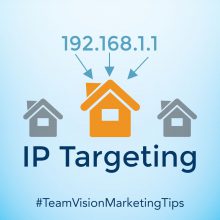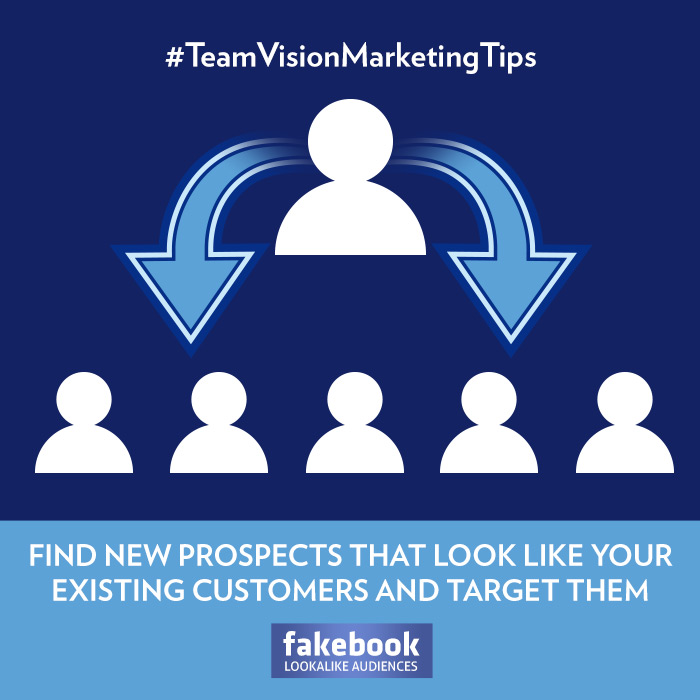
January 18, 2019
Facebook Advertising – Lookalike Audience Marketing
Phone: (808) 536-0416

January 3, 2019
What is Remarketing and How Do I Get Started?
What is Remarketing and How Do I Get Started?
Remarketing is a powerful way to reconnect with customers who have already visited your web site. It provides you with the opportunity to place highly targeted ads in front of a defined audience of users that have already visited your web site and know about your brand – as they browse through other web sites across the Net. Here at Team Vision, we use our own remarketing ad campaigns to remind past visitors about our brand with fun and creative messaging.
If you’ve landed here on our blog while searching for our main site, please visit the Team Vision main site. Otherwise, please continue on.
Why Should I Use Remarketing Campaigns?
There are many reasons why we highly recommend Google remarketing to our clients. First, unlike traditional display advertising, you are not casting a wide net and just hoping your ad gets in front of someone who is actually interested in your product or service. With remarketing, you are speaking directly to prospective customers who have already visited your web site and know about your company. Remarketing gives you the immediate opportunity to remind those prospects about your business and with a very targeted message. For example, if your goal is to sell a product or service, you can put a special offer in the ad that relates to specific pages those prospects went to on your web site. If you’re looking to improve brand awareness, you could craft a clever branding message and run the campaign over a period of time (flighting) targeting your key target audiences.
How Do I Set Up a Remarketing Campaign?
If you have experience using AdWords, Google Analytics, and some basic web site management skills, you may be able to set it up and manage the program yourself. However, we recommend working with a company that has experience creating and managing ongoing remarketing campaigns for multiple clients because they will know how to most effectively optimize your campaigns for the lowest CPC (cost-per-click) and greatest ROI based on their ongoing experience and learning. First, you will need to add a remarketing tag to all pages of your web site code (Note: You must achieve 100 Cookie ID’s on each remarketing list before your campaign will become active). Next, you will need to set up your campaign criteria such as targeting, bid type, ad schedule (day and times you want your ads to run), conversion tracking, max bid cost, etc. Finally, you will need to design your display ads and upload them to AdWords. There are quite a few standard display ad sizes. At Team Vision Marketing, we normally create 15 to 18 ad size variations for each campaign so that we achieve the most placements, and so our ads run in their original format and are not distorted or resized.
How Does Google Remarketing Work?
Remarketing works by placing a cookie on the devices of those visitors who already visited your web site, and who also meet the predefined criteria you set up in AdWords. Their cookie ID is then added to your remarketing lists. Your targeting can be broad (i.e. you can target anyone who visited your web site, or you can target visitors who visited a specific page on your web site but didn’t make a purchase or complete an action). You can set up multiple remarketing lists in your campaign, and you can create display ads that speak directly to the prospects on each list.
Where Will My Remarketing Ads Show up?
Your remarketing ads will appear on any web site that participates in the Google AdWords Display Network. The Google Display Network is the largest and most visited website group on the internet. In fact, the Display Network has the ability to reach 90% of Internet users worldwide. Through AdWords, you have the ability to target specific sites as well as exclude sites that may not be inline with your brand (i.e. sites with sexual content, violence, politic sites, etc.). You have the ability in AdWords Placements Report to see exactly which sites your ads appeared on.
Access your Placements Report
- Click into your display campaign
- Select “Display Network” Tab
- Select “Placements”: This will give you all the high-level domains showing your ad
How Will I Know If My Remarketing Campaign Is Successful?
The great thing about any digital online marketing campaign is that everything is 100% trackable. At a basic level, you will be able to monitor impressions, click-throughs, cost-per-clicks and cost per conversions on a daily basis. With conversion tracking code implemented, you will also be able to track sales revenues by campaign, by ad set and by specific ad. Another great benefit of remarketing is that you can easily modify campaign settings and ads on a regular basis until you achieve the goals you initially set out to accomplish.
What If I Need Help Getting Started?
If you’d like even more in-depth information about Google and Facebook/Instagram remarketing programs, or if you need help setting up and managing your program, contact us at (808) 536-0416, visit our web site at www.www.teamvision.com, or email us at info@www.teamvision.com
View samples of our online marketing, banner ads and remarketing ads in our extensive online portfolio at www.www.teamvision.com/portfolio.
Links to Team Vision Remarketing Campaign Examples:
- How to Select The Best Hawaii Advertising Agency for Your Business
- How AI Will Transform Marketing
- What Is IP Targeting and How Can I Use It for My Business?
- Everything You Need to Know About Instagram’s “Hidden Likes” Test
- Hawaii Social Media Marketing Tips
- How To Succeed in Zero-Click Search SEO
- Social Media Marketing Trends
- Your Guide to Google Rich Search Features
- What to Expect After A Google Broad Core Algorithm Update
- Top 5 Facebook Story Sticker Tips
- Hawaii Search Engine Optimization – SEO Companies
- Top 10 Instagram Story Sticker Tips
- Know The Common Difference: Black Hat SEO vs. White Hat SEO
- 10 Types of Content That Will Boost Engagement
- Video Advertising is Growing – Are You Making the Shift?
- Why You Should Advertise on Facebook Messenger
- Buying Instagram Followers – Is It Worth The Money?
- Top 10 Instagram Hashtag Tips for 2019
- 2018 Social Media Trends: Were We Right On The Money?
- Dreaded Advertising Agency Requests Roundup
Call Us Today at (808) 536-0416.
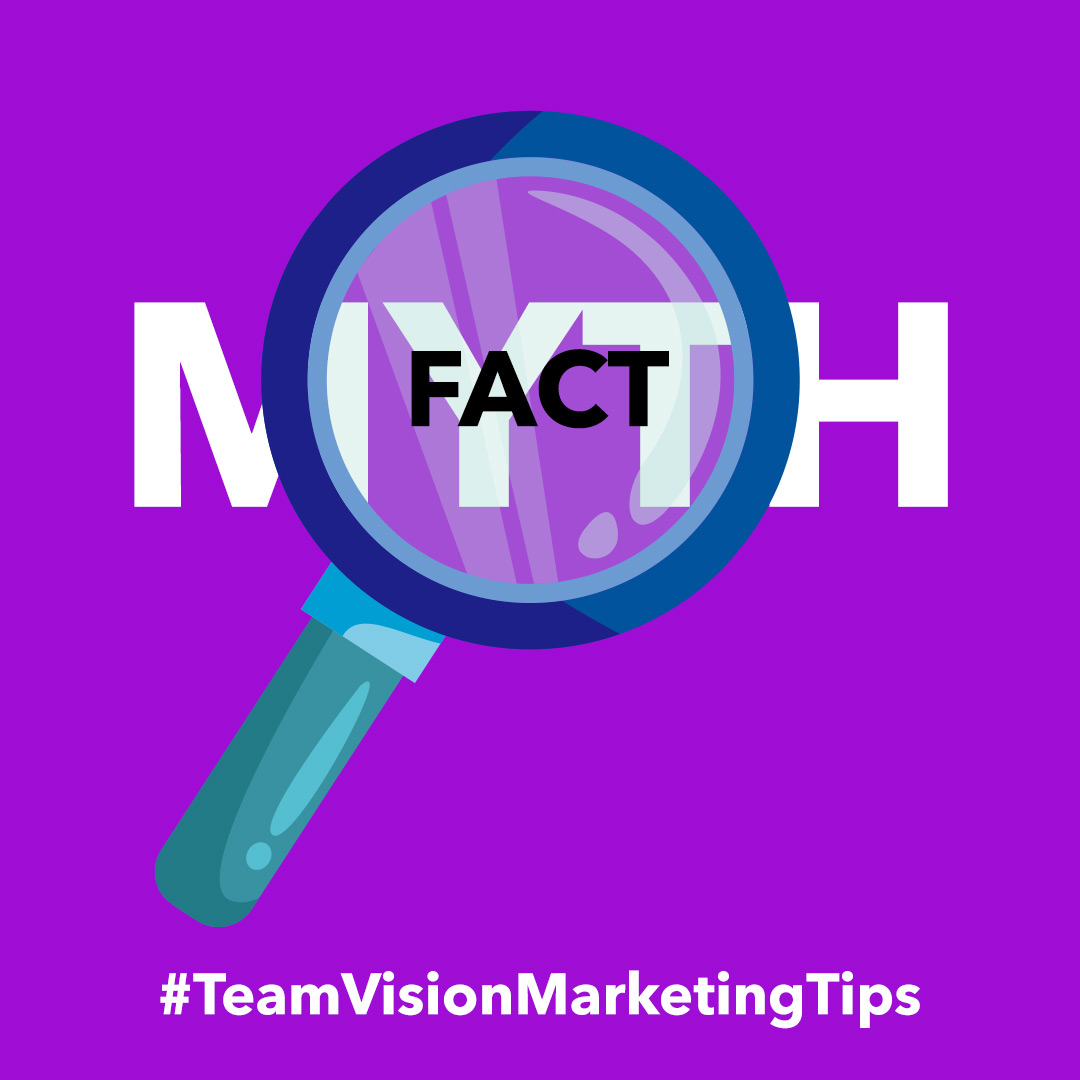
July 12, 2018
Busting Social Media Marketing Myths #3
Busting Social Media Marketing Myths #3
Welcome to part three of Busting Social Marketing Myths. Social Media Marketing has been an essential tool for digital marketing agencies for years now, but some businesses still believe in some misconceptions surrounding it. Believing in these myths can prevent you from having a good social media presence. We feel it’s our responsibility to bust some of these common myths and help steer your business in the right direction.
Make sure to read Busting Social Media Marketing Myths #1 and Busting Social Media Marketing Myths #2 for more busts on social media marketing myths.
Myth: Social Media Is Just A Sales Tool
Social media is a unique marketing channel, where brands can connect with their followers. It’s not all about making sales, it’s also about cultivating a community. If your feed is all about brand promotion and every post is always in a corporate voice, it will make the feed feel ingenuine and it might discourage the followers from wanting to engage with your posts.
To cultivate your community, we suggest that your brand do three things:
- Post a variety of content to keep your feed interesting and refreshing. To get some ideas on what types of content to post, read “Social Media – Tips”.
- Engage with your audience by replying to their comments on posts, following them, and liking and commenting on their posts.
- Spark a conversation on your feed by encouraging your followers to give their input or answer a thought-provoking question. Then, respond to their comments. Make sure to tag their handle in the reply, so they get a notification of your response.
Myth: I Must Post My Own Content ONLY
Social media was created for people to share and spread content, so your brand shouldn’t feel like it has to be the sole content creators on your social media profiles. We get it, sometimes your team doesn’t have the time or the resources to constantly develop their own engaging content. That’s why we recommend that our clients include retweeting, sharing other people’s content, or creating repost campaigns as part of their overall social media marketing plan.
Depending on what your marketing goals are, brands can use reposts and retweets/shares to gain credibility, increase engagement, build relationships with your followers, increase brand awareness, or add personality to your feed. Brands can also combine their repost campaign with their events, contests, giveaways, and so on.
To gain credibility and increase engagements, we highly recommend that companies share articles and posts from influencers or leaders in their field. Don’t be afraid to share your opinion, explain further, question, challenge, or encourage your followers to share their thoughts on the shared post or article. Spark the conversation and get those engagements!
A good way for a brand to build stronger relationships with their followers and increase their brand awareness is to create a repost campaign. This will show people that companies care about their consumers and reposting their content can be seen as a form of consumer testimony. See examples from our Dole Plantation repost campaign below.
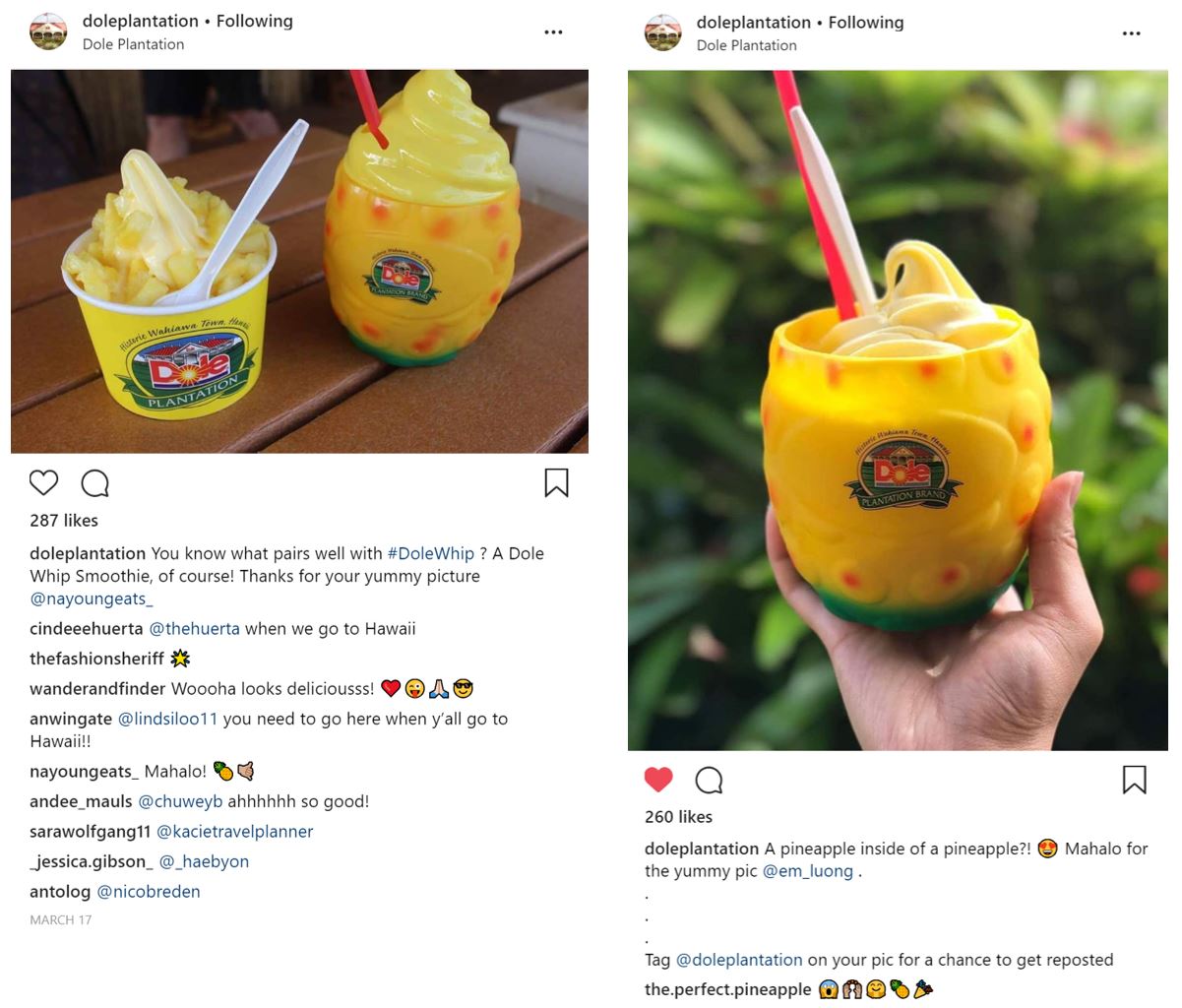
- Create a unique hashtag, preferably something that no one else is using.
- Encourage people to use it and tag your profile on their pictures.
- Then, select the best photos or posts to be shared on your feed.
Brands can also repost or retweet/share fun content that can add some personality to the feed. It can be a scenic photo of the beach, a funny GIF, a recipe, or a Buzzfeed quiz. See examples of fun shared content from Castle & Cooke Homes Hawaii’s Facebook feed below.
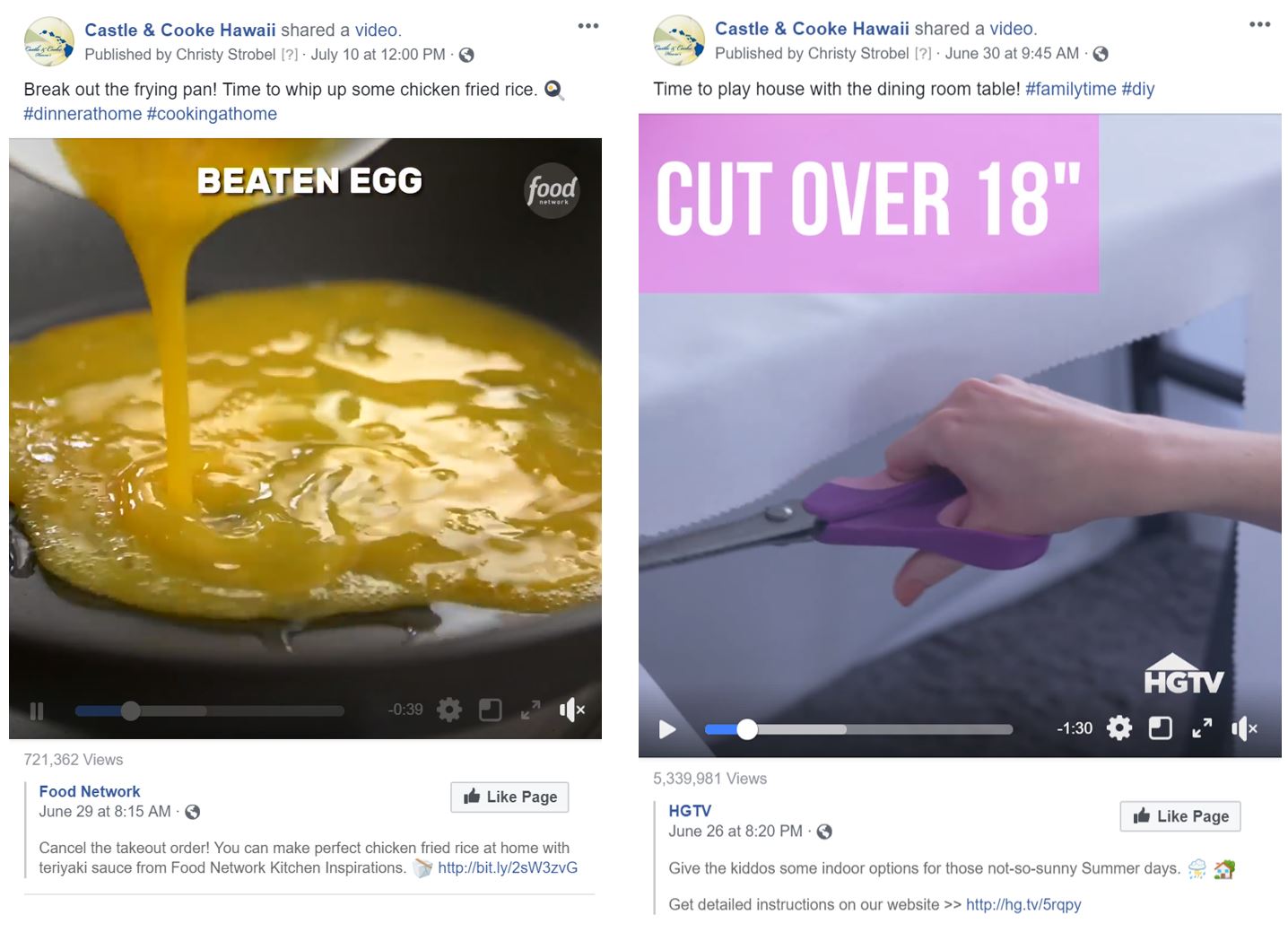
Myth: It’s OK To Just Repost/Share Images I Found
It’s vital for brands to make sure that for whatever they do on any type of media, that it’s done legally and properly. So naturally, a brand cannot just repost or retweet/share without crediting the original author or poster. “If you would normally seek out permission to use content in the offline world, you should do so when posting another’s content to social media”, says Oliver Herzfeld in “Fair Use In The Age Of Social Media“.
For reposting images, we highly suggest that brands get permission from the original poster, either in the comments section of the specific picture or by direct messaging the owner. In our experience with the repost campaigns we’re managing for our clients, their followers are more than happy to let our clients share their content, and they appreciate that we asked for their permission. Once permission is granted and documented, you should clearly state the photo credit to the original source and tag them in the repost. See the Dole Plantation reposts below as an example.

If the reposted picture is from an Influencer or photographer, you may have to pay to use their content, but this can lead to a brand partnership opportunity. If the reposted picture will be used for an ad, like the Honua Kai Resort & Spa’s #HKMemories sponsored ad below, a photo release form should be signed by the original poster.

For retweets on Twitter and shares on Facebook, we recommend tagging the original poster in the retweet or shared post, even though it shows which profile the post was shared from because it’s always better to be cautious.
Myth: Delete All Negative Comments And Block The Haters!
Although it’s tempting, a brand shouldn’t delete a negative comment or block the person who posted it. This could lead to further drama and even more negative comments. The best way to deal with the situation is by politely thanking them for their feedback. Tell them you appreciate their input and that you are always looking for both positive and critical feedback to improve your brand. Don’t defend yourself directly; it never comes across well in written form and usually brings on more negative commentary, according to Sherry Jhawar in “12 Social Media Mistakes That Will Drive Followers Away From Your Brand”.
If your business needs assistance with the management of your social media accounts, give Team Vision Marketing a call and let us help you out. In the meantime, check out some of our social media programs and promotions on our web site portfolio at www.www.teamvision.com/portfolio/#social-media.
Phone: (808) 536-0416
Email: info@www.teamvision.com
Enjoy this article? Let us know below or share it!
Read More Team Vision Blog Posts on Social Media:
“Busting Social Media Marketing Myths #1″
Hear from Bruce Barrett, VP of Sales & Marketing at Castle & Cooke Hawaii, on his experience working with Team Vision Marketing.
- How to Select The Best Hawaii Advertising Agency for Your Business
- How AI Will Transform Marketing
- What Is IP Targeting and How Can I Use It for My Business?
- Everything You Need to Know About Instagram’s “Hidden Likes” Test
- Hawaii Social Media Marketing Tips
- How To Succeed in Zero-Click Search SEO
- Social Media Marketing Trends
- Your Guide to Google Rich Search Features
- What to Expect After A Google Broad Core Algorithm Update
- Top 5 Facebook Story Sticker Tips
- Hawaii Search Engine Optimization – SEO Companies
- Top 10 Instagram Story Sticker Tips
- Know The Common Difference: Black Hat SEO vs. White Hat SEO
- 10 Types of Content That Will Boost Engagement
- Video Advertising is Growing – Are You Making the Shift?
- Why You Should Advertise on Facebook Messenger
- Buying Instagram Followers – Is It Worth The Money?
- Top 10 Instagram Hashtag Tips for 2019
- 2018 Social Media Trends: Were We Right On The Money?
- Dreaded Advertising Agency Requests Roundup







